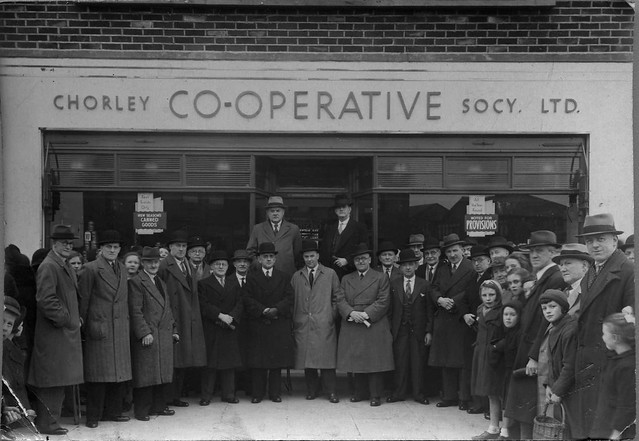In this book, the authors trace the development of The Co-operative Group and its predecessor, the Co-operative Wholesale Society (CWS), over the course of 150 years. Sam MacAulay finds a fascinating account of the historical conditions that gave rise to cooperatives, shedding light on the ups, downs and the often brutal political struggle to legitimise a new organizational form.
 Building Co-operation: A Business History of The Co-operative Group, 1863-2013. John F. Wilson, Anthony Webster, and Rachael Vorberg-Rugh. Oxford University Press. October 2013.
Building Co-operation: A Business History of The Co-operative Group, 1863-2013. John F. Wilson, Anthony Webster, and Rachael Vorberg-Rugh. Oxford University Press. October 2013.
The last ten years or so has seen a resurgence of interest in alternative forms of economic organization. This dialogue hasn’t been confined to activists in movements like Occupy Wall Street. Politicians like the conservative UK Prime Minister are even talking about “transforming capitalism” by reinvigorating and reinventing classic organizational forms. People are looking to go beyond the classic hierarchical corporation and in doing so dramatically reshape economic and social life, addressing problems ranging from rising economic insecurity and wealth concentration, through to declining productivity and workplace satisfaction.Open source communities like Linux garnered a lot of early attention, but as authors like DiMaggio and Schneiberg point out, there are a wealth of alternatives ranging from partnerships right through to cooperatives and mutuals. When you throw in the potential of new digital technologies like 3D printing and virtualization to disrupt and transform the economics of organizing, you can begin to appreciate why scholars are talking seriously (once again) about the end of the classic corporation and the impending transformation of capitalism.
Exciting times I hear you say. Absolutely. And, if you want to begin to understand what this era of organizational innovation might have in store for us, I suggest you race out and grab yourself a copy of Wilson, Webster and Vorberg-Rugh’s interesting new book Building Co-operation: A Business History of The Co-operative Group, 1863-2013. Here is a book that traces the evolution of a fascinating and revolutionary organizational form over its 150-year history. Wilson, Webster and Vorberg-Rugh cover a huge amount of terrain in their book. I am not going to attempt a comprehensive review, instead I want to focus in on their discussion of the cooperative as an organizational form and see what The Group’s history might tell us about the current era of organizational innovation.
The Co-operative Group emerged during a period of organizational ferment somewhat similar to that today, with the exception that today’s debates on organizational form pale in comparison; in comparison they look more like friendly banter at a Sunday picnic. This period in the early 19th century saw a new found market power wielded ruthlessly by local mills and bakers, a collapse in the traditional norms used to price goods, increasing problems with food adulteration, food riots and even violent class conflict. Social activists responded by experimenting with new forms of economic organization that enabled them to better integrate their social values into the task of production and exchange.
Wilson, Webster and Vorberg-Rugh focus on co-operatives as a form of economic organization, where co-operatives are defined as:
“an autonomous association of persons united voluntarily to meet their common economic, social, and cultural needs and aspirations through a jointly-owned and democratically-controlled enterprise” (p. 1-2)
The authors provide a fascinating account of the historical conditions that gave rise to cooperatives in the UK. Importantly, they show that a single dominant design did not emerge over night, but rather the modern day cooperative was produced through years of experimentation by a motley mix of activists ranging from Christian socialists through to atheists like Robert Owen. Broadly, they wanted to replace a capitalist system of production with a cooperative one: where consumers would have a direct voice in production and where quality goods could be provided to the local community at wholesale prices. The organizational principles (p. 37-38) eventually settled on to achieve these goals were first codified in the mid-19th Century by a cooperative called The Rochdale Pioneers. The seven core principles have proved remarkably persistent over time and survive in operation to the present day:
- Democracy, one member one vote
- Accountability for management and leadership of the society: regular general meetings, election of officers and directors on the democratic principle.
- The quantity of share help by a member did not influence their voting power.
- Open membership meant that anyone could join, including women.
- Political and religious neutrality
- Fixed and limited interest was paid on share capital
- Dividends were distributed based on how much you purchased. More equals more.
Sitting here in the modern day, it’s hard to appreciate just how revolutionary these principles were. Just think: in a class-ridden era, an era without universal suffrage, here was an organization committed to universal membership and democratic decision-making! Imagine yourself as a working class housewife sitting there and thinking: I am off to debate my co-operative’s expansion plans, hold that manager to account for his dodgy bread and then vote on the course of action I see as right. It must have been very empowering. Lots of people joined the movement and membership in CWS (The Co-operative Group’s main predecessor) swelled from 18,337 in 1864 to 721,316 in 1890.

The authors document, in great detail, how the Group’s fortunes went up and down over subsequent years. But to this day, The Co-operative Group remains a major force within the UK market (even with its recent crisis). This history has something in it for most scholars interested in organizations: there are fascinating tensions in organizational identity (e.g. consumer vs. worker cooperative), complex social movement processes (e.g. the rise and fall of democratic decision-making), resource-dependency dynamics (e.g. the relationship between the notionally independent wholesale and the retail societies), and innovation processes (e.g. the search for new organizational designs).
What I found most interesting about this history, though, was the light it sheds on the often brutal political struggle to legitimise a new organizational form. Cooperatives had to stand up to protests, boycotts and parliamentary intervention. Non-cooperative retailers lobbied employers (e.g. railroads), asking them to pressure their employees into abandoning cooperative membership (p. 111). Scotland saw private traders form themselves into anti-cooperative “defence association” that pressured employers into firing employees who were cooperative members. In St. Helens, the local Traders’ Defence Association launched a major boycott in 1902, not just banning trade with cooperatives, but also refusing to employ any cooperative members or their family relations! Parliament was also lobbied, with non-co-operative retailers and their allies seeking to introduce laws that would hinder co-operative competitiveness (what today we would term non-market strategy!). People were deeply invested in the dominant organizational forms associated with classic capitalist firms and they were not about to give up without a fight. That is as true today as it was then.
Wilson, Webster and Vorberg-Rugh’s book is very strong on this sort of historical detail and I am sure it will provide grist to scholars for many years to come. But that’s perhaps one of the book’s main limitations. I can’t see anyone else but a dedicated scholar (and perhaps a few diehard fans from the co-operative movement) reading the book. It’s tough going in parts. The writing is densely packed with historical facts that do not serve any clear analytical purpose (e.g. the salary held by the head of CWS’s tea department p. 83) and there is far too much repetition (e.g. I lost count of how many times I was formulaically told about the ‘cooperative principle of sourcing goods as close as you can to the point of production’). And although the impact of changes in structure and strategy are a core message in the book, there is a glaring absence of organizational charts that would help make these changes concrete. The Co-operative Group was a gargantuan organization and verbal descriptions of its structure were not sufficient for me to clearly keep track of what was going on. This is a shame because, as the authors themselves note, there is a distinct lack of discussion about this important organizational form within business education. Given this, I really do hope the authors consider repackaging their excellent content into a format that would be easier to digest.
Until then, let me applaud the efforts made by Wilson, Webster and Vorberg-Rugh. The painstaking work they’ve done in this book will ultimately help educate people about alternative organizational forms like cooperatives. This knowledge is crucial. What it means is that we can have a well-informed discussion about the building blocks that are already out there. And with these blocks in hand, hopefully, people will be better equipped to learn from the lessons of the past when they set out to reorganize the future.
—————————–
Sam MacAulay is a Post-Doctoral Research Fellow at Imperial College London’s Business School. He studies the organisation of innovation, particularly the manner in which patterns of cooperation, competition and conflict shape the innovation process. When he’s not researching, writing, teaching or reviewing books, Sam tweets @sam_macaulay and blogs at imperial-business-blog.com. Read more reviews by Sam.








1 Comments